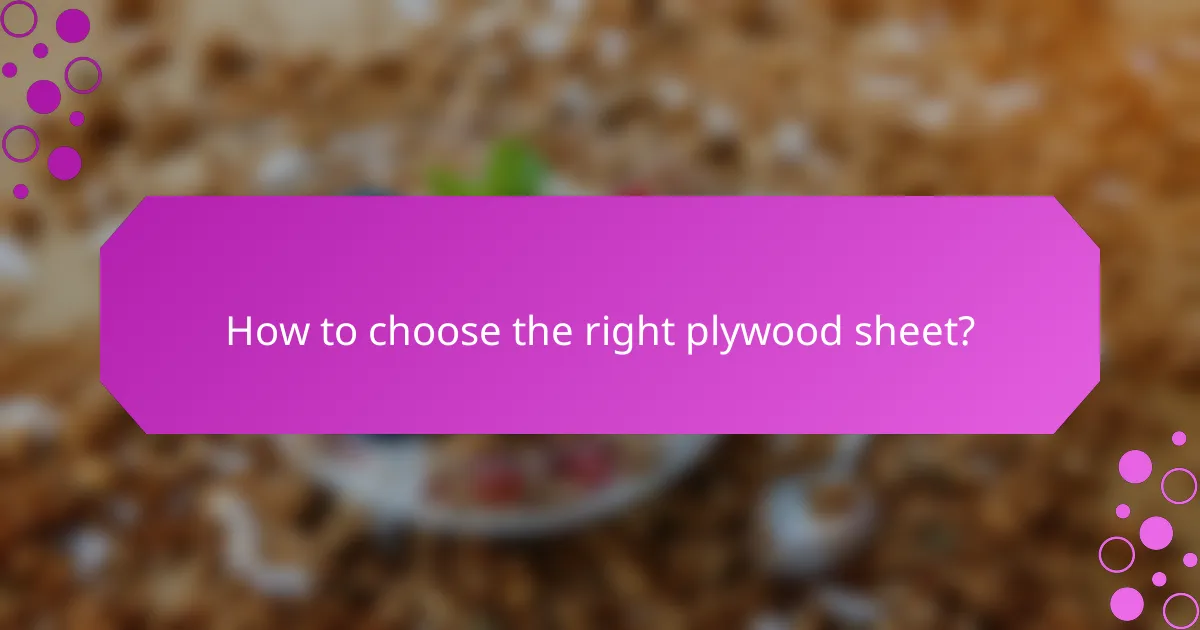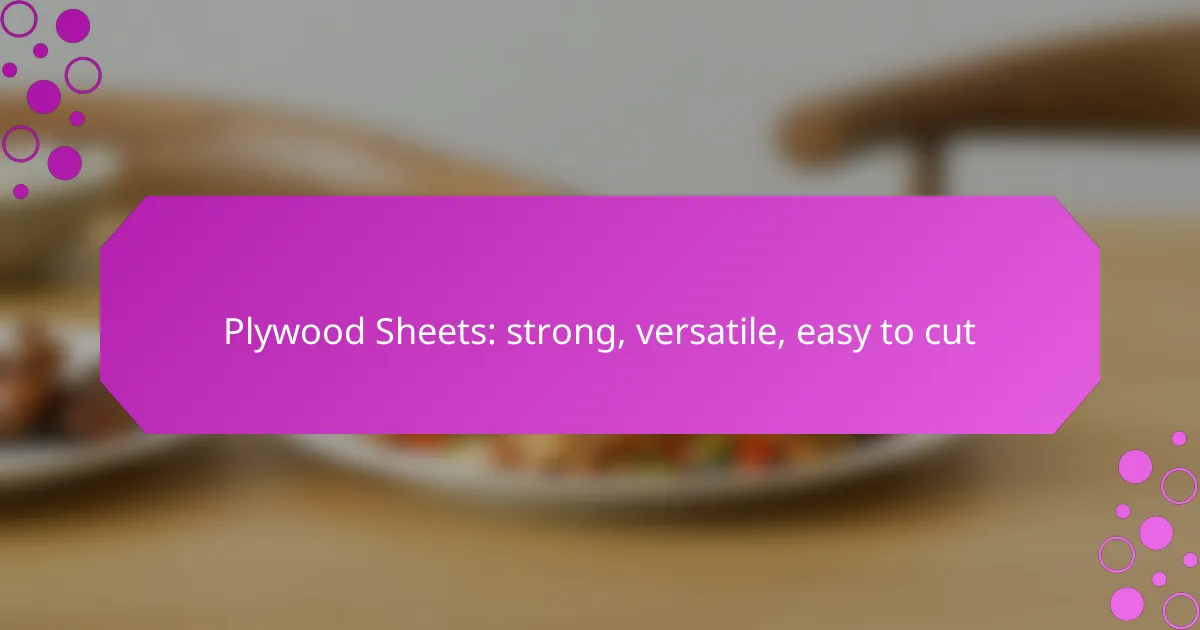Plywood sheets are a strong and versatile material, perfect for a wide range of applications in both residential and commercial projects. Their ease of cutting and shaping allows for creative solutions tailored to specific needs, making them a popular choice among builders and DIY enthusiasts alike.

What are the best uses for plywood sheets in New Zealand?
Plywood sheets are highly versatile and strong, making them ideal for various applications in New Zealand. Their ability to be easily cut and shaped allows for creative and functional uses in both residential and commercial projects.
Furniture construction
Plywood is a popular choice for furniture construction due to its durability and aesthetic appeal. It can be used to create everything from tables and chairs to cabinets and shelves. When selecting plywood for furniture, consider thickness and finish to ensure it meets both functional and design needs.
Common thicknesses for furniture range from 12mm to 18mm, providing a sturdy base while remaining lightweight. Additionally, applying a veneer or laminate can enhance the appearance and protect the surface.
Flooring applications
Plywood sheets are often used as underlayment for flooring installations, providing a stable surface for tiles, vinyl, or hardwood. They help to minimize noise and improve insulation, making them a practical choice for residential and commercial spaces.
For flooring, a thickness of at least 15mm is recommended to ensure stability and durability. Ensure the plywood is moisture-resistant, especially in areas prone to humidity, such as bathrooms and kitchens.
Wall paneling
Plywood can be an excellent option for wall paneling, offering a warm and natural look. It can be used in both interior and exterior applications, adding character and insulation to spaces. When using plywood for wall paneling, consider the grain direction and finish to achieve the desired aesthetic.
For interior walls, thinner sheets around 9mm to 12mm are often sufficient, while exterior applications may require thicker options for added strength against the elements.
Craft projects
Plywood sheets are ideal for various craft projects, from home decor to model building. Their ease of cutting allows for intricate designs and shapes, making them a favorite among DIY enthusiasts. Popular craft uses include creating signs, toys, and decorative items.
When working on craft projects, consider using thinner plywood, typically around 3mm to 6mm, as it is easier to manipulate and cut. Ensure you have the right tools, such as a jigsaw or laser cutter, for precision work.
Outdoor structures
Plywood is suitable for constructing outdoor structures like sheds, decks, and garden furniture. Its strength and resistance to warping make it a reliable choice for outdoor use. When using plywood outdoors, opt for marine-grade or treated plywood to withstand moisture and pests.
For outdoor projects, a thickness of at least 18mm is advisable for structural integrity. Regular maintenance, such as sealing and painting, will extend the lifespan of plywood in outdoor environments.

How to choose the right plywood sheet?
Choosing the right plywood sheet involves considering factors such as thickness, grade, wood species, and finish options. Each of these elements plays a crucial role in determining the plywood’s strength, appearance, and suitability for your specific project.
Thickness considerations
The thickness of plywood sheets typically ranges from about 3 mm to 25 mm, with common sizes being 6 mm, 12 mm, and 18 mm. Thicker sheets provide greater strength and durability, making them ideal for structural applications, while thinner sheets are suitable for lightweight projects.
When selecting thickness, consider the intended use. For example, furniture and cabinetry often require 12 mm to 18 mm sheets, while decorative paneling may only need 6 mm. Always ensure the thickness aligns with the load-bearing requirements of your project.
Grade selection
Plywood grades are classified from A to D, with A being the highest quality and D the lowest. Grade A sheets are smooth and free of defects, making them perfect for visible surfaces, while lower grades may have knots and imperfections suitable for hidden applications.
When choosing a grade, think about the final appearance and function. For furniture, opt for A or B grades, while C or D grades can be used for structural framing or subflooring where aesthetics are less critical.
Type of wood species
The species of wood used in plywood affects its strength, weight, and cost. Common species include birch, oak, and pine, each offering different characteristics. Birch plywood is known for its durability and fine grain, while pine is lighter and more affordable.
Consider the environmental conditions and the project’s requirements when selecting wood species. For outdoor projects, marine-grade plywood made from water-resistant species like Douglas fir may be necessary to withstand moisture and decay.
Finish options
Plywood can be finished in various ways, including staining, painting, or sealing. The choice of finish impacts both the appearance and durability of the plywood. For example, a clear sealant can enhance the natural beauty of wood grain, while paint can provide a uniform look.
When deciding on a finish, consider the plywood’s end use. For high-traffic areas, a durable finish like polyurethane may be advisable, while decorative projects might benefit from a simple stain or varnish. Always test finishes on a small area to ensure compatibility and desired results.

What are the cutting techniques for plywood sheets?
Cutting plywood sheets can be accomplished using various techniques, each suited for different applications and precision levels. The choice of method depends on the desired cut quality, the tools available, and the specific project requirements.
Using a circular saw
A circular saw is a popular tool for cutting plywood due to its speed and efficiency. To achieve clean cuts, use a fine-toothed blade designed for plywood, and set the depth of the blade to just slightly deeper than the thickness of the sheet.
When cutting, support the plywood on a stable surface and ensure it is secured to prevent movement. A straight edge or guide can help maintain accuracy, especially for long cuts. Always wear safety gear, including goggles and ear protection, to safeguard against debris and noise.
Employing a jigsaw
A jigsaw is ideal for making intricate cuts and curves in plywood sheets. It offers versatility but may require a slower cutting speed to avoid splintering. Use a fine-toothed blade specifically designed for wood to achieve smoother edges.
Before starting, mark your cut line clearly and secure the plywood to prevent shifting. For best results, cut from the back side of the plywood to minimize visible splintering on the finished side. Remember to keep the jigsaw steady and let the tool do the work without forcing it through the material.
Benefits of a table saw
A table saw provides precision and control, making it an excellent choice for straight cuts on plywood sheets. It allows for repeatable cuts and is particularly useful for larger sheets where accuracy is critical.
When using a table saw, ensure the blade is sharp and set to the correct height. Use a fence to guide the plywood through the blade for consistent results. This method is especially effective for making multiple identical cuts, such as when creating cabinetry or furniture components.

What are the advantages of using plywood sheets?
Plywood sheets offer numerous advantages, including strength, versatility, and ease of use. These engineered wood products are ideal for a variety of construction and crafting applications, making them a popular choice among builders and DIY enthusiasts alike.
Strength and durability
Plywood sheets are known for their impressive strength and durability, making them suitable for both structural and non-structural applications. The layers of wood veneer are glued together in a cross-grain pattern, which enhances their resistance to warping and cracking.
When properly treated, plywood can withstand moisture and heavy loads, making it a reliable choice for flooring, roofing, and furniture. For example, marine-grade plywood is specifically designed to resist water damage, making it ideal for boat construction and outdoor projects.
Versatility in applications
The versatility of plywood sheets allows them to be used in a wide range of applications, from home construction to artistic projects. They can be easily cut, shaped, and finished, making them suitable for everything from cabinetry to decorative wall panels.
In addition to traditional uses, plywood is increasingly being utilized in innovative ways, such as in furniture design and architectural features. Its adaptability makes it a favorite among designers and builders looking for creative solutions.
Cost-effectiveness
Plywood sheets are often more cost-effective than solid wood, providing a similar aesthetic and functionality at a lower price point. This affordability makes plywood an attractive option for large-scale projects where budget constraints are a concern.
When comparing costs, consider the long-term value of plywood, as its durability can lead to lower maintenance and replacement expenses. For instance, using plywood for subflooring can save money compared to other materials while still providing a sturdy foundation.
Lightweight properties
One of the significant advantages of plywood sheets is their lightweight nature, which makes them easy to handle and transport. This characteristic is particularly beneficial for DIY projects and renovations where maneuverability is essential.
Despite being lightweight, plywood maintains a high strength-to-weight ratio, allowing it to support substantial loads without adding excessive weight to structures. This feature is especially advantageous in applications like wall sheathing and roofing, where reducing overall weight can enhance structural efficiency.

What are the environmental considerations for plywood?
Environmental considerations for plywood include sustainable sourcing practices and the material’s recyclability. Understanding these aspects can help consumers make informed choices that minimize ecological impact.
Sustainable sourcing
Sustainable sourcing of plywood involves obtaining wood from responsibly managed forests that adhere to environmental standards. Certifications such as FSC (Forest Stewardship Council) ensure that the wood is harvested in a way that preserves biodiversity and supports local communities.
When selecting plywood, look for products labeled with sustainability certifications. This not only promotes responsible forestry but also encourages manufacturers to maintain eco-friendly practices.
Recyclability of plywood
Plywood is generally recyclable, making it a more environmentally friendly option compared to some other materials. When disposed of properly, it can be repurposed into new products or used as biomass for energy production.
To maximize recyclability, avoid mixing plywood with other materials during construction or disposal. Check local recycling guidelines, as some areas have specific programs for wood waste that can help divert plywood from landfills.

How to properly maintain plywood sheets?
To maintain plywood sheets effectively, keep them dry, clean, and protected from excessive moisture and direct sunlight. Regular inspections and proper storage can significantly extend their lifespan.
Cleaning plywood sheets
Cleaning plywood sheets involves removing dust and debris with a soft cloth or a vacuum. For tougher stains, use a mild detergent mixed with water, applying it gently to avoid damaging the surface.
Avoid using harsh chemicals or abrasive materials, as they can scratch or weaken the plywood. After cleaning, ensure the sheets are thoroughly dried to prevent moisture damage.
Storing plywood sheets
Store plywood sheets in a dry, well-ventilated area to minimize exposure to moisture. Ideally, keep them elevated off the ground and stacked flat to prevent warping.
Use a cover or tarp if storing outdoors, but ensure it allows for air circulation to avoid trapping humidity. Regularly check the storage area for signs of dampness or pests.
Protecting plywood sheets
To protect plywood sheets, consider applying a sealant or finish that is suitable for your intended use, especially if they will be exposed to moisture. Options include varnishes, paints, or water-resistant coatings.
Additionally, avoid placing heavy objects on the sheets to prevent indentations and damage. If using plywood in high-traffic areas, consider edge banding to protect against chipping.
